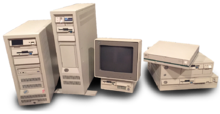 | |
 An assortment of PS/2s in various form factors[a] | |
| Also known as | PS/2 |
|---|---|
| Developer | International Business Machines Corporation (IBM) |
| Manufacturer | IBM |
| Type | Personal computers |
| Release date | April 2, 1987 |
| Discontinued | July 1995 |
| Media |
|
| Operating system | |
| CPU | Various; see list of models |
| Graphics | VGA |
| Power | 120/240 VAC ~ (desktops) |
| Predecessor | Personal Computer AT |
| Successor |
|
| Related | |
The Personal System/2 or PS/2 is IBM's second generation[1][2] of personal computers. Released in 1987, it officially replaced the IBM PC, XT, AT, and PC Convertible in IBM's lineup. Many of the PS/2's innovations, such as the 16550 UART (serial port), 1440 KB 3.5-inch floppy disk format, 72-pin SIMMs, PS/2 port, and VGA video standard, went on to become standards in the broader PC market.[3][4]
The PS/2 line was created by IBM partly in an attempt to recapture control of the PC market by introducing the advanced yet proprietary Micro Channel architecture (MCA) on higher-end models. These models were in the strange position of being incompatible with the hardware standards previously established by IBM and adopted in the IBM PC compatible industry. Most major PC manufacturers balked at IBM's licensing terms for MCA-compatible hardware, particularly the per-machine royalties. The OS/2 operating system was announced at the same time as the PS/2 line and was intended to be the primary operating system for models with Intel 80286 or later processors. However, at the time of the first shipments, only IBM PC DOS 3.3 was available. OS/2 1.0 (text-mode only) and Microsoft's Windows 2.0 became available several months later. IBM also released AIX PS/2, a UNIX operating system for PS/2 models with Intel 386 or later processors.
IBM's initial PS/2 computers were popular with target market corporate buyers, and by September 1988, IBM reported that it had sold 3 million PS/2 machines in the past 18 months. However, the PS/2 was unsuccessful in the consumer market since IBM failed to establish a link in the consumer's mind between the PS/2 MicroChannel architecture and the immature OS/2 1.x operating system (the more capable OS/2 version 2.0 was not released until 1992) to justify the PS/2's price premium, in contrast to rival IBM PC compatibles that stuck with industry-wide standard hardware while running Microsoft Windows.[5] In 1992, Macworld stated that "IBM lost control of its own market and became a minor player with its own technology."[6] IBM officially retired the PS/2 line in July 1995.[7]
Cite error: There are <ref group=lower-alpha> tags or {{efn}} templates on this page, but the references will not show without a {{reflist|group=lower-alpha}} template or {{notelist}} template (see the help page).
- ^ Tooley, Mike (1995). PC-based Instrumentation and Control. Elsevier. p. 19. ISBN 9780080938271. Archived from the original on 2023-04-25. Retrieved 2023-03-21 – via Google Books.
- ^ Clancy, Heather (June 2, 1988). "IBM adds to second generation of personal computers". UPI. p. 219. Archived from the original on February 21, 2022. Retrieved February 21, 2022.
- ^ IBM Personal System/2 Hardware Interface Technical Reference (PDF). IBM. May 1988. 68X2330. Archived from the original (PDF) on 2020-10-29. Retrieved 2016-11-26.
- ^ "PS/2 Reference Manuals". MCA Mafia. 2006-03-04. Archived from the original on 2016-11-03. Retrieved 2016-11-26.
- ^ McCracken, Harry (2 April 2012). "25 Years of IBM's OS/2: The Strange Days and Surprising Afterlife of a Legendary Operating System". Time. Archived from the original on 30 September 2015. Retrieved 29 September 2015 – via techland.time.com.
- ^ Borrell, Jerry (May 1992). "Opening Pandora's Box". Macworld. pp. 21–22.
- ^ Singh, Jai (April 10, 1995). "MCA, PS/2 bite the dust; OS/2 to follow?". InfoWorld. 17 (15): 3. Archived from the original on November 9, 2023. Retrieved August 17, 2021.